light Lexus GS350 2007 Using the front audio system / LEXUS 2007 GS430/350 (OM30A04U) Owner's Guide
[x] Cancel search | Manufacturer: LEXUS, Model Year: 2007, Model line: GS350, Model: Lexus GS350 2007Pages: 562, PDF Size: 17.95 MB
Page 94 of 562
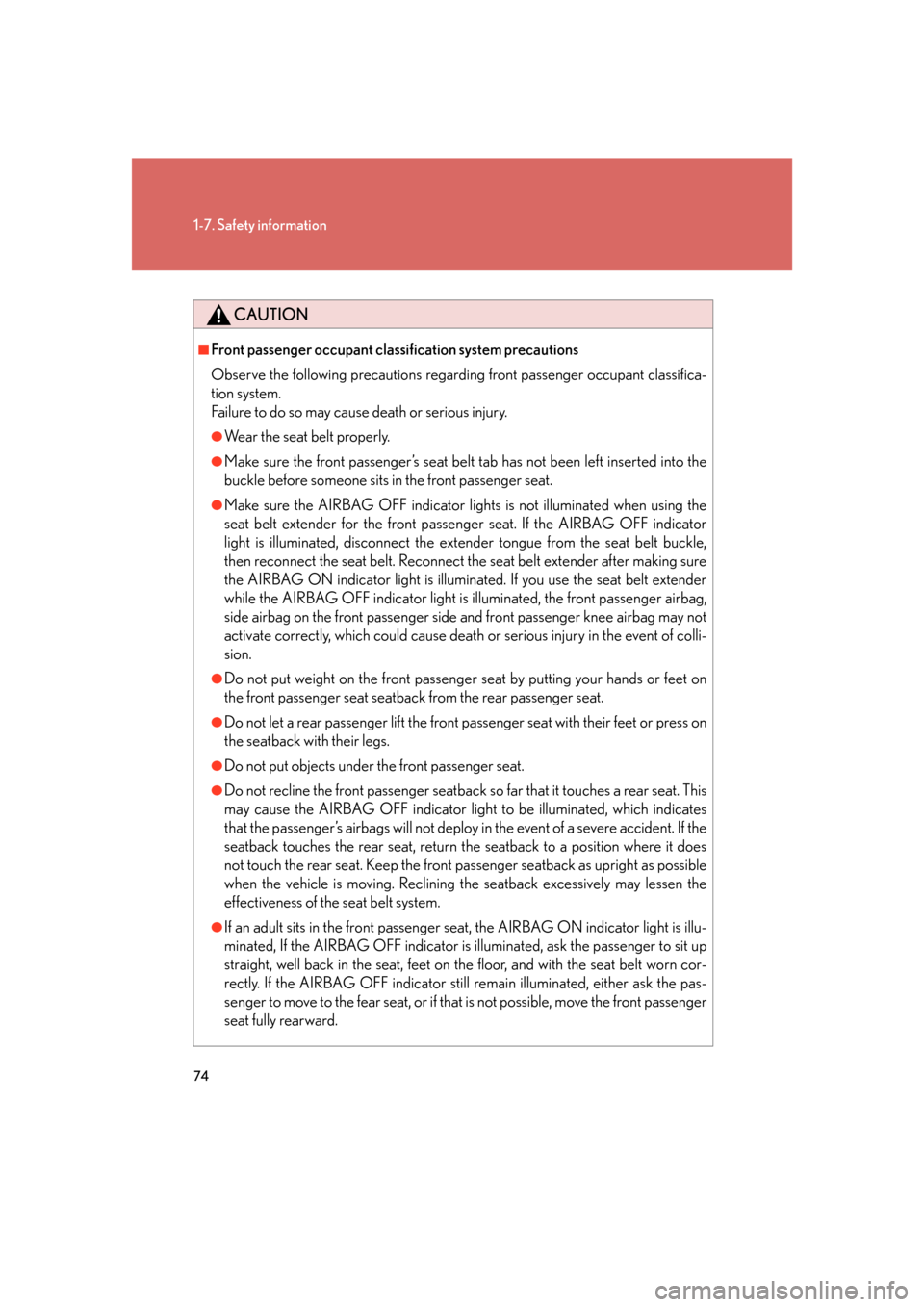
74
1-7. Safety information
CAUTION
■Front passenger occupant classification system precautions
Observe the following precautions regardin g front passenger occupant classifica-
tion system.
Failure to do so may cause death or serious injury.
●Wear the seat belt properly.
●Make sure the front passenger’s seat belt tab has not been left inserted into the
buckle before someone sits in the front passenger seat.
●Make sure the AIRBAG OFF indicator lights is not illuminated when using the
seat belt extender for the front pass enger seat. If the AIRBAG OFF indicator
light is illuminated, disconnect the extender tongue from the seat belt buckle,
then reconnect the seat belt. Reconnect the seat belt extender after making sure
the AIRBAG ON indicator light is illuminated. If you use the seat belt extender
while the AIRBAG OFF indicator light is il luminated, the front passenger airbag,
side airbag on the front passenger side and front passenger knee airbag may not
activate correctly, which could cause death or serious injury in the event of colli-
sion.
●Do not put weight on the front passenger seat by putting your hands or feet on
the front passenger seat seatback from the rear passenger seat.
●Do not let a rear passenger lift the front passenger seat with their feet or press on
the seatback with their legs.
●Do not put objects under the front passenger seat.
●Do not recline the front passenger seatback so far that it touches a rear seat. This
may cause the AIRBAG OFF indicator light to be illuminated, which indicates
that the passenger’s airbags will not deploy in the event of a severe accident. If the
seatback touches the rear se at, return the seatback to a position where it does
not touch the rear seat. Keep the front pa ssenger seatback as upright as possible
when the vehicle is moving. Reclining the seatback excessively may lessen the
effectiveness of the seat belt system.
●If an adult sits in the front passenger se at, the AIRBAG ON indicator light is illu-
minated, If the AIRBAG OFF indicator is il luminated, ask the passenger to sit up
straight, well back in the seat, feet on the floor, and with the seat belt worn cor-
rectly. If the AIRBAG OFF indicator still remain illuminated, either ask the pas-
senger to move to the fear seat, or if that is not possible, move the front passenger
seat fully rearward.
Page 95 of 562
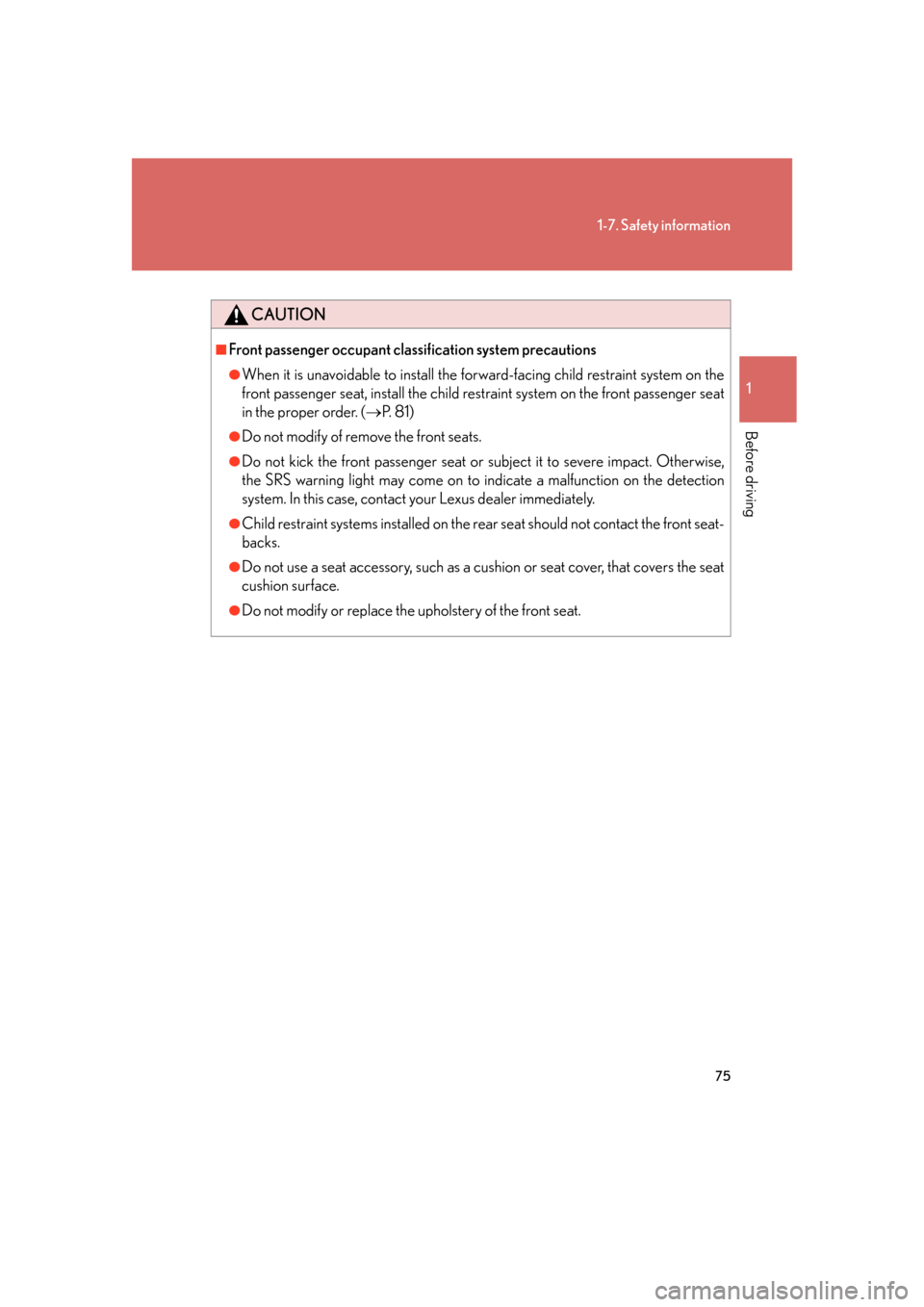
75
1-7. Safety information
1
Before driving
CAUTION
■Front passenger occupant classification system precautions
●When it is unavoidable to install the forw ard-facing child restraint system on the
front passenger seat, install the child rest raint system on the front passenger seat
in the proper order. ( P. 8 1 )
●Do not modify of remove the front seats.
●Do not kick the front passenger seat or subject it to severe impact. Otherwise,
the SRS warning light may come on to in dicate a malfunction on the detection
system. In this case, contact your Lexus dealer immediately.
●Child restraint systems installed on the rear seat should not contact the front seat-
backs.
●Do not use a seat accessory, such as a cushion or seat cover, that covers the seat
cushion surface.
●Do not modify or replace the upholstery of the front seat.
Page 98 of 562
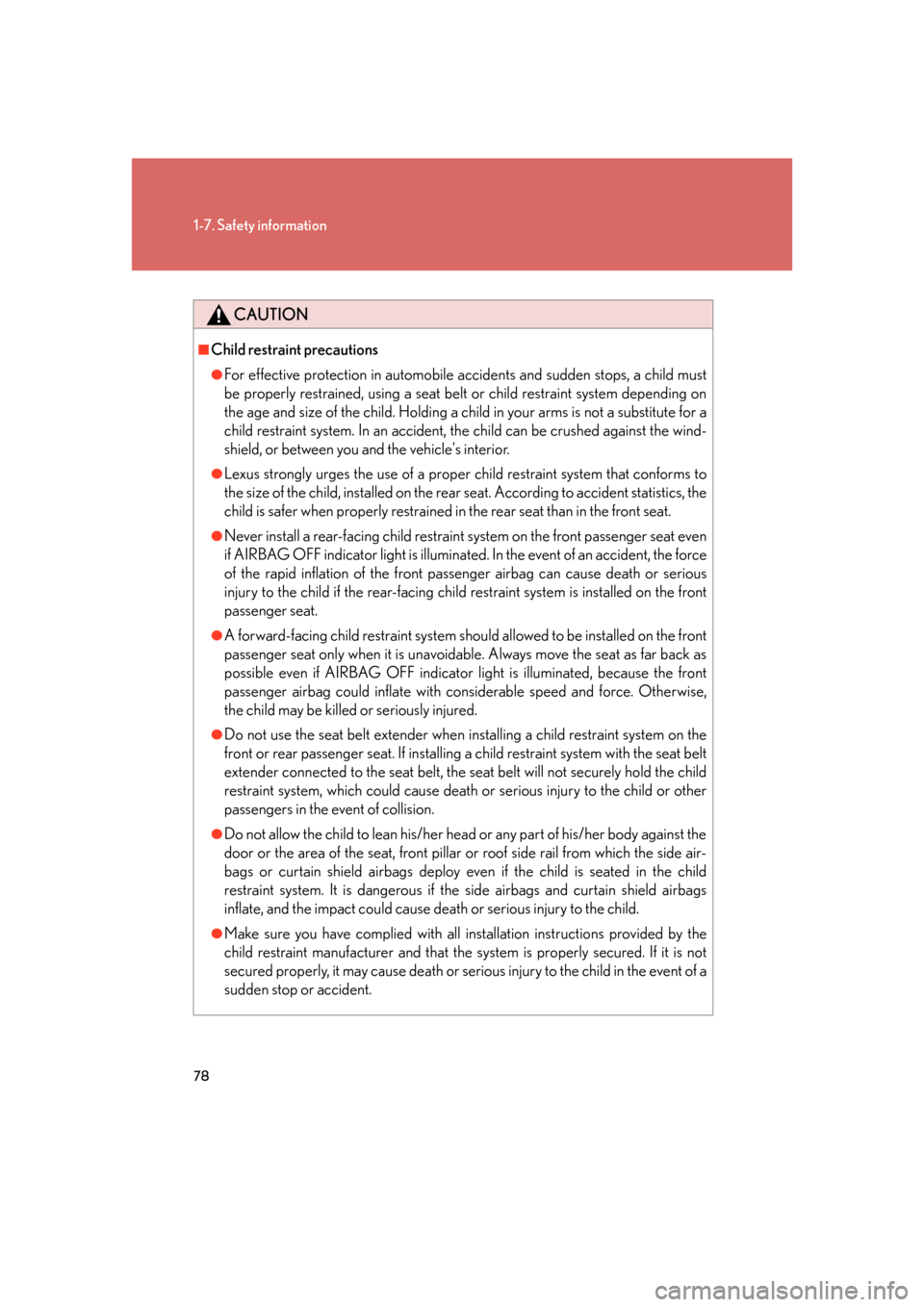
78
1-7. Safety information
CAUTION
■Child restraint precautions
●For effective protection in automobile accidents and sudden stops, a child must
be properly restrained, using a seat belt or child restraint system depending on
the age and size of the child. Holding a child in your arms is not a substitute for a
child restraint system. In an accident, th e child can be crushed against the wind-
shield, or between you and the vehicle's interior.
●Lexus strongly urges the use of a proper child restraint system that conforms to
the size of the child, installed on the rear seat. According to accident statistics, the
child is safer when properly restrained in the rear seat than in the front seat.
●Never install a rear-facing child restraint system on the front passenger seat even
if AIRBAG OFF indicator light is illuminated. In the event of an accident, the force
of the rapid inflation of the front passenger airbag can cause death or serious
injury to the child if the rear-facing child restraint system is installed on the front
passenger seat.
●A forward-facing child restraint system shou ld allowed to be installed on the front
passenger seat only when it is unavoidable. Always move the seat as far back as
possible even if AIRBAG OFF indicator light is illumi nated, because the front
passenger airbag could inflate with considerable speed and force. Otherwise,
the child may be killed or seriously injured.
●Do not use the seat belt extender when installing a child restraint system on the
front or rear passenger seat. If installing a child restraint system with the seat belt
extender connected to the seat belt, the seat belt will not securely hold the child
restraint system, which could cause death or serious injury to the child or other
passengers in the event of collision.
●Do not allow the child to lean his/her head or any part of his/her body against the
door or the area of the seat, front pillar or roof side rail from which the side air-
bags or curtain shield airbags deploy even if the child is seated in the child
restraint system. It is dangerous if the side airbags and curtain shield airbags
inflate, and the impact could cause death or serious injury to the child.
●Make sure you have complied with all inst allation instructions provided by the
child restraint manufacturer and that the sy stem is properly secured. If it is not
secured properly, it may cause death or serious injury to the child in the event of a
sudden stop or accident.
Page 100 of 562

80
1-7. Safety information
Installing child restraints using a seat belt (child restraint lock function belt)
■Rear facing child seat Infant/convertible
Place the child seat on the rear
seat facing the r
ear of the vehicle.
Run the seat belt through the infant
seat and inser
t the plate into the
buckle. Make sure that the belt is
not twisted.
Fully extend the shoulder belt and
then allo
w it to retract slightly in
order to activate the ALR lock
mode.
Lock mode allows the seat belt to
retract only.
STEP1
STEP2
STEP3
Page 101 of 562

81
1-7. Safety information
1
Before driving
While pushing the child seat down
into the rear seat, allow the shoul-
der belt to retract until the child
seat is secur
ely in place.
After the shoulder belt has
retracted to a point where there is
no slack in the belt, pull the belt to
check that it cannot be extended.
■Forward facing Convertible child seat
Place the child seat on the seat
facing the fr
ont of the vehicle.
Run the seat belt through the child
seat and inser
t the plate into the
buckle. Make sure that the belt is
not twisted.
Fully extend the shoulder strap and
then allo
w it to retract slightly into
the ALR lock mode.
Lock mode allows the seat belt to
retract only.
STEP4
STEP1
STEP2
STEP3
Page 103 of 562

83
1-7. Safety information
1
Before driving
Removing a child restraint installed with a seat belt
Push the buckle release button
and fully retract the seat belt.
Installation with child restraint lower anchorages
Type AWiden the gap between
the seat cushion and seat-
back slightly.
Latch the hooks of the
lower straps onto the
anchor
ages.
If the child restraint has a top
strap, the top strap should be
latched onto the anchorage.
For owners in Canada:
The symbol on a child restraint sys -
tem indicates the presence of a
lo
wer anchorage system.
Canada only
STEP1
STEP2
Page 104 of 562

84
1-7. Safety information
Type BWiden the gap between
the seat cushion and seat-
back slightly.
Latch the buckles onto the
anchorages.
If the child restraint has a top
strap, the top strap should be
latched onto the anchorage.
For owners in Canada:
The symbol on a child restraint sys -
tem indicates the presence of a
lo
wer anchorage system.
Child restraint systems with a top strap
Secure the child restraint using a
seat belt or lower anchors, and
lock the head restraint in place at
the lowest position.
Canada only
STEP1
STEP2
STEP1
Page 106 of 562
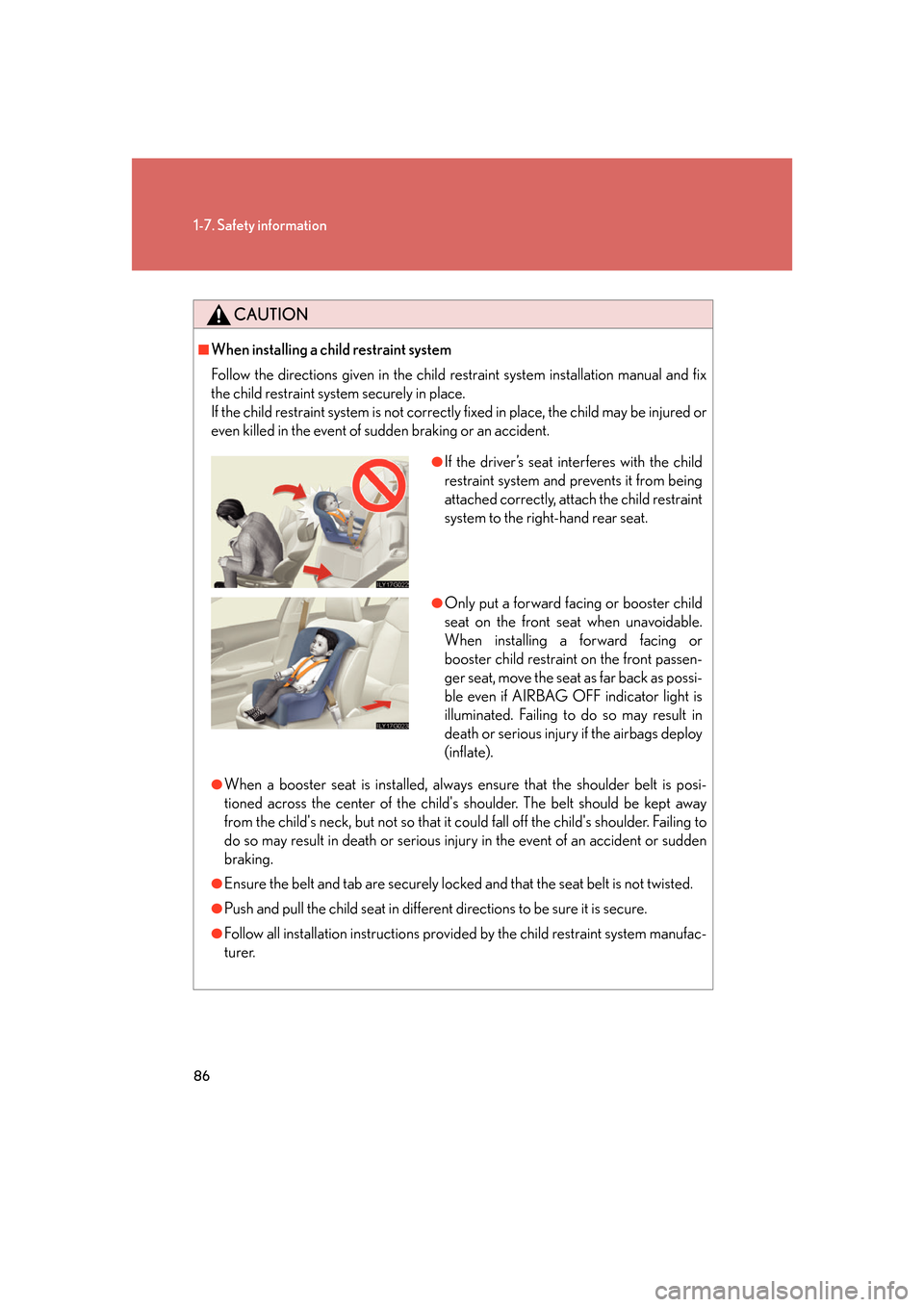
86
1-7. Safety information
CAUTION
■When installing a child restraint system
Follow the directions given in the child restraint system installation manual and fix
the child restraint system securely in place.
If the child restraint system is not correctly fixed in place, the child may be injured or
even killed in the event of sudden braking or an accident.
●When a booster seat is installed, always ensure that the shoulder belt is posi-
tioned across the center of the child's sh oulder. The belt should be kept away
from the child's neck, but not so that it could fall off the child's shoulder. Failing to
do so may result in death or serious inju ry in the event of an accident or sudden
braking.
●Ensure the belt and tab are securely locked and that the seat belt is not twisted.
●Push and pull the child seat in different directions to be sure it is secure.
●Follow all installation instructions provid ed by the child restraint system manufac-
turer.
●If the driver’s seat interferes with the child
restraint system and prevents it from being
attached correctly, attach the child restraint
system to the right-hand rear seat.
●Only put a forward facing or booster child
seat on the front seat when unavoidable.
When installing a forward facing or
booster child restraint on the front passen-
ger seat, move the seat as far back as possi-
ble even if AIRBAG OFF indicator light is
illuminated. Failing to do so may result in
death or serious injury if the airbags deploy
(inflate).
Page 109 of 562
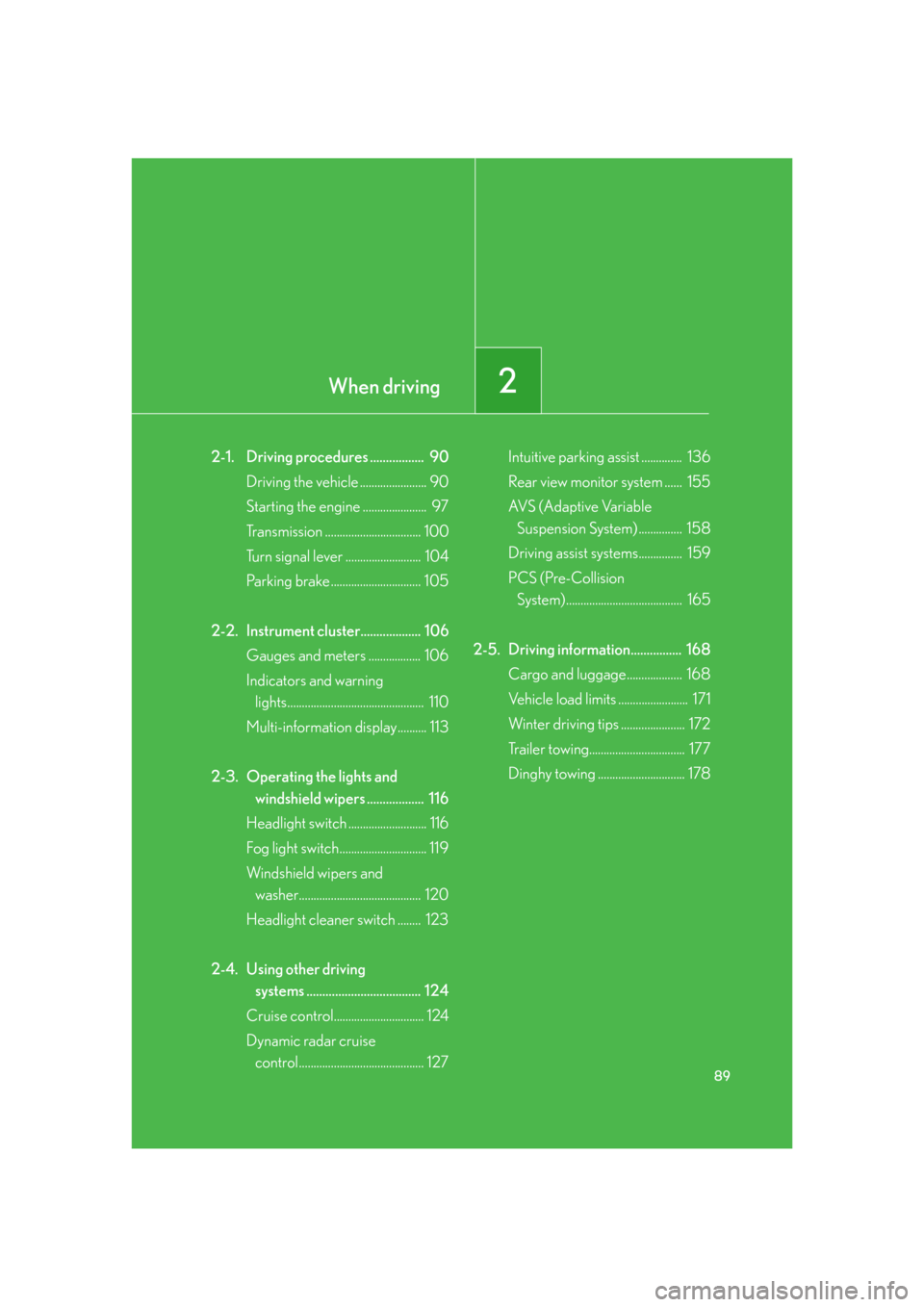
When driving2
89
2-1. Driving procedures ................. 90Driving the vehicle ....................... 90
Starting the engine ...................... 97
Transmission ................................. 100
Turn signal lever .......................... 104
Parking brake ............................... 105
2-2. Instrument cluster................... 106 Gauges and meters .................. 106
Indicators and warning
lights............................................... 110
Multi-information display.......... 113
2-3. Operating the lights and
windshield wipers .................. 116
Headlight switch ........................... 116
Fog light switch.............................. 119
Windshield wipers and
washer.......................................... 120
Headlight cleaner switch ........ 123
2-4. Using other driving
systems .................................... 124
Cruise control............................... 124
Dynamic radar cruise
control........................................... 127 Intuitive parking assist .............. 136
Rear view monitor system ...... 155
AVS (Adaptive Variable
Suspension System) ............... 158
Driving assist systems............... 159
PCS (Pre-Collision
System)........................................ 165
2-5. Driving information................ 168 Cargo and luggage................... 168
Vehicle load limits ........................ 171
Winter driving tips ...................... 172
Trailer towing................................. 177
Dinghy towing .............................. 178
Page 114 of 562
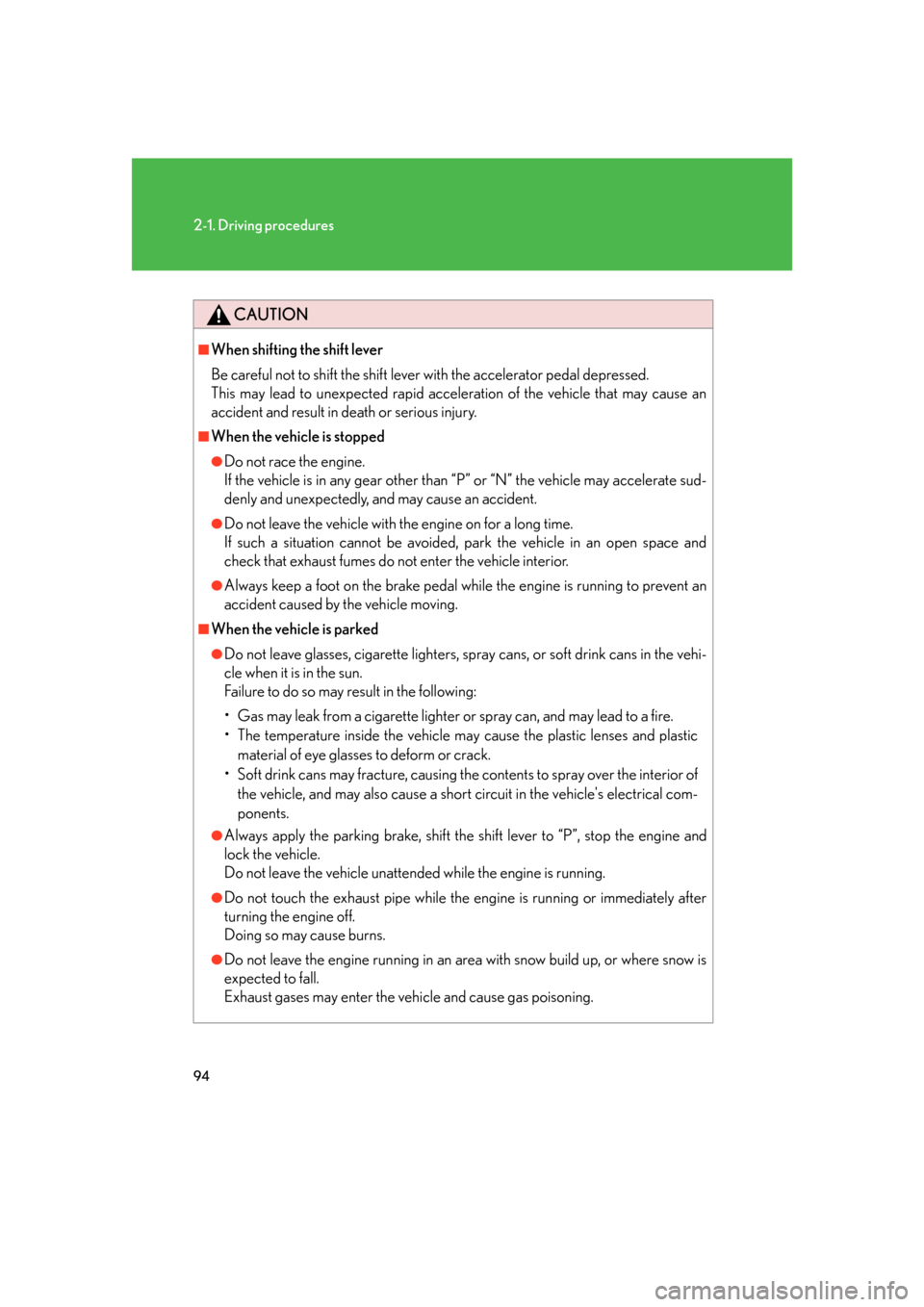
94
2-1. Driving procedures
CAUTION
■When shifting the shift lever
Be careful not to shift the shift lever with the accelerator pedal depressed.
This may lead to unexpected rapid acceleration of the vehicle that may cause an
accident and result in death or serious injury.
■When the vehicle is stopped
●Do not race the engine.
If the vehicle is in any gear other than “P” or “N” the vehicle may accelerate sud-
denly and unexpectedly, and may cause an accident.
●Do not leave the vehicle with the engine on for a long time.
If such a situation cannot be avoided, park the vehicle in an open space and
check that exhaust fumes do no t enter the vehicle interior.
●Always keep a foot on the brake pedal while the engine is running to prevent an
accident caused by the vehicle moving.
■When the vehicle is parked
●Do not leave glasses, cigarette lighters, spray cans, or soft drink cans in the vehi-
cle when it is in the sun.
Failure to do so may result in the following:
• Gas may leak from a cigarette lighter or spray can, and may lead to a fire.
• The temperature inside the vehicle may cause the plastic lenses and plastic material of eye glasses to deform or crack.
• Soft drink cans may fracture, causing the contents to spray over the interior of the vehicle, and may also cause a short circuit in the vehicle's electrical com-
ponents.
●Always apply the parking brake, shift the shift lever to “P”, stop the engine and
lock the vehicle.
Do not leave the vehicle unattend ed while the engine is running.
●Do not touch the exhaust pipe while the engine is running or immediately after
turning the engine off.
Doing so may cause burns.
●Do not leave the engine running in an area with snow build up, or where snow is
expected to fall.
Exhaust gases may enter the vehicle and cause gas poisoning.